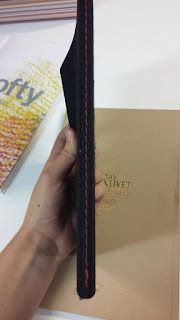We had a member of G F Smith come in to talk to use all about different stocks and their products, and how these stocks have been used to create interesting items and publications, to give us some inspiration for our current publication brief.
These are some of the examples of products that G F Smith have produced. Some are products for clients, and others are colour books, showcasing their vast array of stocks.
 |
| Colourplan colour book. It has tear off aspects so you can tear off parts of each colour, creating interesting patterns such as this example, also so you can see how different colours work together as well. |
 |
| This colourplan book has an interesting binding method as well, being a simple stitch, however the thread used is multicoloured, so it will change colours as it goes down the spin, which reflects the different coloured stock within. This is really interesting and created such a unique aesthetic as well. |
 |
| This is a unique cover for a book, with a beetle in spot UV varnish, highlighting it without the use of an ink as such, a subtle effect which reflects characteristics of the beetle, being stealthy. The stock used for the cover is an unusual almost fabric kind of stock, similar to felt in a way in texture. |
 |
| This book also has an interesting stitched spine, using red thread, which contrasts really boldly against the black cover, whilst also hinting at danger, black and red being colours associated with this. |
 |
| The thread can be seen in the centre spread of the book, which is an interesting and not messy as you may think detail, creating interest, and making the most of the unusual colour thread. |
 |
| This is another colour palette book for the colourplan range, only an older version, which uses cut out circles to show the different colours against one another, whilst also adding interest on the page. |
 |
| The text is subtly embossed onto the page, adding a unique texture without the use of ink, whilst still being about to read it at closer examination. |
 |
| I think this ia another example of G F Smith's colour swatch books, only this time it has a very unusual fold, where you can only open it one way and then the other, but somehow unfold it as well, which completely befuddled me, as I couldn't work it out, so perhaps this is one of their less successful publications, but still a magnificently looking one. |
 |
| Packaging for marshmallows, much more upscale than the usual plastic wrapping. The colours are effective as they reflect the flavour of the marshmallows. The stock used is excellent, showcasing the ability to duplex, with the grey outside and deep red inside colours, which adds an extra level of sophistication to this design as well. |
 |
| This is a leather look stock which has been used for this sample book, but with the title embossed on the front ever so subtly, which can hardly be seen especially in this photograph and with the texture so prominent. |
 |
| Here you can view samples of each colour and weight of the stock, to get a real feel of the stock itself. The colours of the stock all work very effectively together, being all a similar shade of orange/brown. |
 |
| This is a fantastic spine, with coptic bind being used on an open spine to produce an intricate and bold appearance, especially when coupled with the exposure of the different coloured stock used as well. This is a real special element to a perhaps seemingly ordinary book from the front. Coptic binding also works really effectively if you have a large page number book that doesn't want to be perfect bound, as the book being broken down into sections means you can still achieve is a very hand rendered, natural approach similar to saddle stitch, but you won't get the oversplay, and the pages can be opened at a full 180 degree angle, unlike Japanese bind for example, which would requite a fold at the spine to open fully, an even then it won't lie fully flat like coptic binding. |
The talk with G F Smith and a chance to have a look at some of their samples was really beneficial as I got a much better understanding of the kinds of stock they produce and what the processes of making a book (which they can also do) are in the commercial world, as this is very different to making a book in the studio. Looking at the samples also showed how the different stocks can be used to gain maximum effect, and what you can do with them as well, such as finishes and binding methods as well. There isn't just a standard, there's so much variety that I didn't realise properly beforehand.














No comments:
Post a Comment